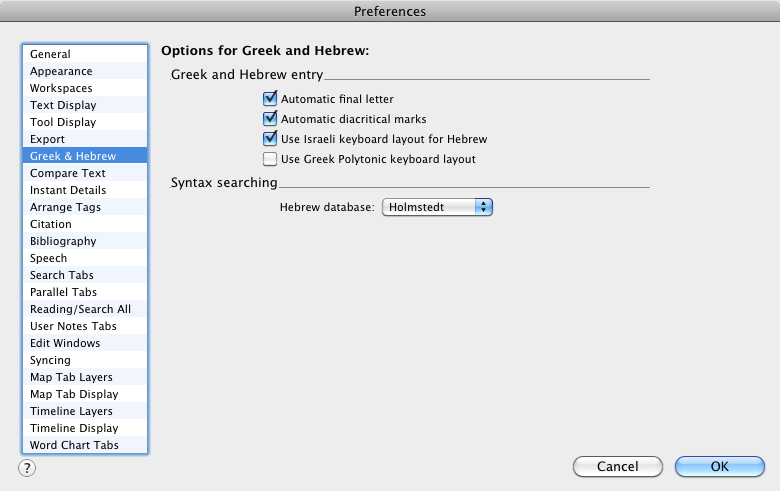Open topic with navigation
You are here: Comprehensive Reference > Dialog Boxes > Preferences Dialog Box > Preferences: Greek & Hebrew Area
Preferences: Greek & Hebrew
Prerequisites for use: None; this dialog box can be opened at any time.
Use: The Greek & Hebrew preferences set the defaults for use of the original languages.
Open: Click Greek & Hebrew in the list of the Preferences dialog box. The Greek and Hebrew area is displayed.
Options in the Greek and Hebrew Area of the Preferences Dialog Box
Greek and Hebrew entry Area: Options in this area affect keyboard entry of Greek and Hebrew text.
- Automatic final letter: When selected, alters the form of certain Greek and Hebrew letters depending on their position in the word.
- As you enter the word, the final form, for example of the Greek sigma or the Hebrew mem, appears. But if this letter is followed by another letter, the previous letter reverts to the regular form.
- In Syriac the correct form (standalone, beginning, middle, or ending) is used automatically.
- Automatic diacritical marks: Affects the various overstrike characters—accents and breathing marks and their combinations in Helena (Greek), and vowel points and other marks in Yehudit (Hebrew).
- When selected, you can enter any of the overstrike positions of the specific accent or mark, and Accordance will put the character or the combination with the correct amount of overstrike for the previous or following letter.
- This option also applies to the diacritical marks in the following Accordance fonts: Sylvanus, Peshitta, and Rosetta.
- Use Israeli keyboard layout for Hebrew: When selected, converts keyboard entry to the layout used by Nisus, Israeli, and other Hebrew right-to-left systems. Text can then be entered as in a Hebrew right-to-left word processor.
- Use Greek Polytonic keyboard layout: When selected, converts keyboard entry to a modern Greek keyboard layout for Helena (not Sylvanus Uncial).
Accent characters use the modern Greek keyboard layout character positions, but, like the Accordance overstrike accents, they are typed after rather than before the vowel. The iota subscript is entered with Alt+i followed by “i”.
Syntax Searching Area: Options in this area relate to the selected language database.
- Hebrew Database: If both databases are installed, you can choose between the Holmstedt and WHS Hebrew language database. Your selection impacts the default database used for Hebrew searches, and items that appear in the Search>Tag menu.
You are here: Comprehensive Reference > Dialog Boxes > Preferences Dialog Box > Preferences: Greek & Hebrew Area
Open topic with navigation



